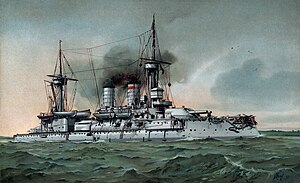Ottoman battleship Barbaros Hayreddin

1899 lithograph of SMS Kurfürst Friedrich Wilhelm
|
|
| History | |
|---|---|
|
|
|
| Name: | Kurfürst Friedrich Wilhelm |
| Namesake: | Friedrich Wilhelm |
| Builder: | Kaiserliche Werft Wilhelmshaven |
| Laid down: | 1890 |
| Launched: | 30 June 1891 |
| Commissioned: | 29 April 1894 |
| Fate: | Sold to the Ottoman Empire in 1910 |
|
|
|
| Name: | Barbaros Hayreddin |
| Namesake: | Hayreddin Barbarossa |
| Acquired: | 12 September 1910 |
| Fate: | Sunk by the British submarine HMS E11, 8 August 1915 |
| General characteristics | |
| Class and type: | Brandenburg-class battleship |
| Displacement: | 10,670 t (10,500 long tons) |
| Length: | 115.7 m (379 ft 7 in) |
| Beam: | 19.5 m (64 ft 0 in) |
| Draft: | 7.9 m (25 ft 11 in) |
| Installed power: | 9,553 ihp (7,124 kW) |
| Propulsion: | 2-shaft triple expansion engines |
| Speed: | 16.9 knots (31.3 km/h; 19.4 mph) |
| Range: | 4,300 nmi (8,000 km; 4,900 mi) at 10 knots (19 km/h; 12 mph) |
| Complement: |
|
| Armament: |
|
| Armor: | |
SMS Kurfürst Friedrich Wilhelm ("His Majesty's Ship Elector Friedrich Wilhelm") was one of the first ocean-going battleships of the Imperial German Navy. The ship was named for Prince-elector (Kurfürst) Friedrich Wilhelm, 17th-century Duke of Prussia and Margrave of Brandenburg. She was the fourth pre-dreadnought of the Brandenburg class, along with her sister ships Brandenburg, Weissenburg, and Wörth. She was laid down in 1890 in the Imperial Dockyard in Wilhelmshaven, launched in 1891, and completed in 1893 at a cost of 11.23 million marks. The Brandenburg-class battleships carried six large-caliber guns in three twin turrets, as opposed to four guns in two turrets, as was the standard in other navies.
Kurfürst Friedrich Wilhelm served as the flagship of the Imperial fleet from her commissioning in 1894 until 1900. She saw limited active duty during her service career with the German fleet due to the relatively peaceful nature of the late 19th and early 20th centuries. As a result, her career focused on training exercises and goodwill visits to foreign ports. These training maneuvers were nevertheless very important to developing German naval tactical doctrine in the two decades before World War I, especially under the direction of Alfred von Tirpitz. She, along with her three sisters, saw only one major overseas deployment, to China in 1900–01, during the Boxer Rebellion. The ship underwent a major modernization in 1904–05.
...
Wikipedia
